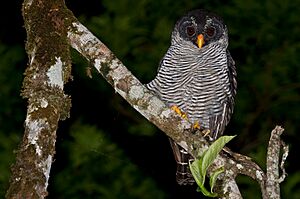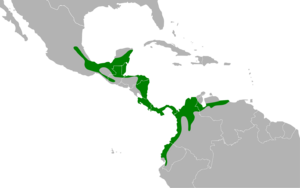Black-and-white owl facts for kids
Quick facts for kids Black-and-white owl |
|
|---|---|
 |
|
| Conservation status | |
| Scientific classification | |
| Genus: |
Strix
|
| Species: |
nigrolineata
|
 |
|
| Synonyms | |
|
Ciccaba nigrolineata (Sclater, 1859) |
|
The black-and-white owl (scientific name: Strix nigrolineata) is a cool type of owl. It belongs to the family called Strigidae, which are often known as "true owls."
Contents
What Does the Black-and-White Owl Look Like?
This owl is a medium-sized bird. It has a round head and no special ear tufts. These owls are usually between 35 and 40 cm (about 14-16 inches) long. They weigh between 400 and 535 grams (about 0.9 to 1.2 pounds).
Like many owl species, the female black-and-white owl is often bigger than the male. Females weigh about 487 grams on average, while males weigh around 418 grams.
Their chest, belly, and underparts have cool black and white stripes. Their upper body, from their head to their tail, is a dark, sooty black. They also have a black and white striped collar around their neck.
The owl's face is mostly sooty black. But it has white "eyebrows" that go from its beak to its collar. Its beak is a bright yellow-orange color, and its eyes are a reddish-brown.
Baby Owls and Young Owls
When they are first born, baby owls are covered in soft, white fuzz. They look very fluffy!
Young owls, called juveniles, have a whitish face. Their upper parts are dark brown, and their underside has black bars on a white background.
Where Does This Owl Fit In? (Taxonomy)
The black-and-white owl used to be in a group called Ciccaba. This group included many owls from the tropical parts of America. Now, it is part of the Strix group, also known as "wood owls." All owls in the Strix group have round heads and dark, black eyes.
A scientist named Sclater first described this owl in 1859. The black-banded owl (Strix hulula) is a close relative. It looks similar but is smaller and has darker feathers. It also lives in a different area, mainly in the southern tropical forests of South America.
Where Does the Black-and-White Owl Live? (Habitat)
You can mostly find the black-and-white owl in gallery forests and rainforests. These are forests that grow along rivers or in very wet areas. They also live in wet forests where trees lose their leaves, and in mangrove forests.
These owls usually live at heights from sea level up to 2400 meters (about 7,900 feet). They often visit small ponds when they are hunting for food. They like to build their nests in the leaves of large, tall trees, like mahogany trees. Interestingly, these owls are not scared to live close to human homes.
Where Can You Find This Owl? (Distribution)
The black-and-white owl's home range stretches from central Mexico all the way south to northwestern Peru and western Colombia. It shares some of this area with another related owl, the mottled owl (Strix virgata).
In total, you can find this owl in 12 countries: Belize, Colombia, Costa Rica, Ecuador, El Salvador, Guatemala, Honduras, Mexico, Nicaragua, Panama, Peru, and Venezuela. This bird of prey does not migrate. It stays in its home range all year long.
How Does the Black-and-White Owl Behave?
Hunting and What They Eat
This owl from the tropics is a nighttime hunter. Since most of its prey can fly, it hunts mostly in the tops of the trees. First, it will sit on a high branch and look around. Then, it will make short, quiet flights to catch its food.
The black-and-white owl mainly eats insects. It especially likes scarab beetles (Scarabaedidae), like dung beetles. Sometimes, it also eats orthopterans (like grasshoppers) and cicadas (Cicadidae).
Bats, such as the Jamaican fruit bat (Artibeus jamaicensis), and other small rodents are also a big part of their diet. Sometimes, they even eat smaller birds like thrushes and tanagers, and also amphibians. This owl is one of the few tropical owls known to catch barn swallows. Barn swallows are easy to catch when they are resting on nearby electric lines.
What Sounds Do They Make?
The black-and-white owl's call is a series of quick, low, gurgling sounds. After a short pause, it makes a low, airy call and a faint, short hoot. Sometimes, they only make the last two notes, leaving out the first part.
The female's call usually sounds louder than the male's. Owls also make fainter "hoots" when they are near their nest. Young owls can make loud cries. They also communicate by clacking their beaks together.
How Do They Have Babies?
The breeding season starts in March. The male owl attracts the female with wing flaps and fancy acrobatic flights. Once they are a pair, they stay together for life (monogamous).
Before the heavy rains begin, the owl couple finds a secluded tree. They choose a spot to protect their offspring from climbing predators. They use epiphytes (plants that grow on other plants) and flower arrangements, like orchids, to build their nest.
The female owl sits on the eggs to keep them warm (incubates). She usually lays one or two eggs. While she is incubating, the male hunts for food for both of them. He also fiercely protects the nest, even from humans who get too close. Sometimes, the female will go hunting with her mate when she is not sitting on the eggs.
The eggs are dull and whitish. They weigh about 33.8 grams, which is usually about 6% of the female's body weight. They are about 46.4 mm (1.83 in) long and 38.4 mm (1.51 in) wide. The black-and-white owl is one of the only owls to lay just one egg. This is because species living closer to the Equator often have fewer eggs. This explains why they don't have many babies at once.
After at least 30 days of incubation, the chicks hatch in April. They are born with white down feathers, pink feet, and a pink beak. After two days, they weigh around 28 grams. They first open their eyes when they are about 14 days old. This is also when the black bars on their wings start to grow.
Young owls have a low chance of survival. They can be hunted by animals like tayras, ocelots, coatis, falcons, and hawks.
What About Their Future? (Conservation Status)
The black-and-white owl is listed as "Least Concern" on IUCN's Red List. This means it is not currently in danger of disappearing. However, its populations are decreasing.
For example, the owl population in Mexico has dropped by 50% in the last century. This has made the species a big concern for the Partners in Flight group.
The biggest threat to this owl is the loss of its wetland and forest homes. These areas are slowly being turned into farms. Living too close to humans also causes their numbers to go down.


